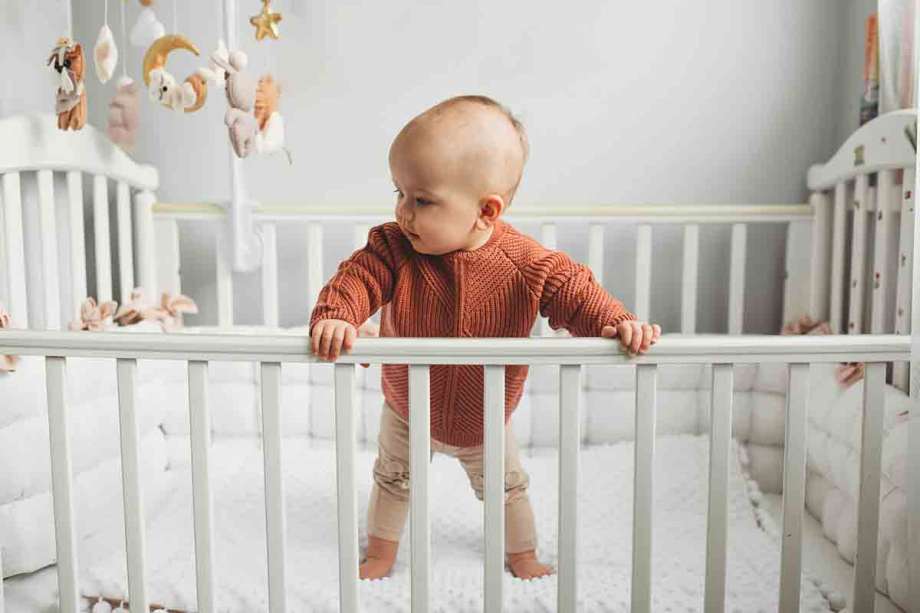When To Lower Your Baby's Crib According to Experts

When you're a first-time parent, there are so many questions about everything having to do with your baby, including crib safety. From how your baby sleeps to making all the adjustments, you need to do your homework to make sure your baby is safe. Making sure you consistently have the right crib mattress height will help determine how safe your baby crib is.
More: The 8 Best Convertible Cribs in 2020
Many parents aren't sure when that magic time is and even how to do it. We're going to take a closer look at various cribs settings, some signs that are sure red flags that it's time to lower the baby crib for your little one, as well as some tips to get it done the right way.
Different Crib Settings
All cribs are different, but there are standard settings that you should be aware of that will help keep your baby's crib safe.
Highest Crib Setting
This setting is usually best for newborns who aren't going to move around much. Many times, babies are still in a sleep sack or a swaddle when they're at this mattress setting. This is usually the setting parents use when they transition their baby from the bassinet to the crib.
Middle Setting
At this point, your baby can move around, but can't stand up on his or her own. The exact time you'll need to switch to this setting will depend on how fast your baby grows.
Lowest Crib Setting
This is the setting you should be eyeing when your baby shows he or she can stand up on his or her own or at least push up on his or her own. You never know when they'll get to the next stage and try to make their way over the rails when you're not looking. Babies are pretty fearless, so you want to be one step ahead of them all of the time.
Signs That It's Time to Lower Your Baby's Crib
It's important to be aware of when your baby's crib needs to be lowered to avoid injury. Every year, 10,000 children are taken to the emergency room for crib-related accidents, with many related to children falling out of their crib. Many children fall out of their crib because they are tall enough to stand up and get out.
Dr. TJ Gold of Tribeca Pediatrics says she advises parents to lower the crib before they think they need to.
"Let’s say once you get to six months but definitely before nine months because children’s milestones are met at such a variable rate," says Gold. "Some kids are sitting all by themselves (without any support) at six months, and some kids are sitting solo at nine months."
Keeping that in mind, here are some other signs that it's time to lower the crib mattress.
- They are trying to pull themselves up to a standing position. If they can do this, there's a chance they will be able to flip themselves over the crib rails.
- They have reached 36 inches. The American Academy of Pediatrics makes this recommendation and advises that at this point they get moved into a toddler bed.
As you consider these recommendations, also keep in mind that the AAP recommends that the crib rail is at least 26 inches from the top of the crib mattress. This is for your baby's safety.
It's important to note that you don't have to drop the crib to the lowest point right away. As long as you are lowering it enough to meet safety standards and safety guidelines, you can do it gradually. It counts to know how active your baby is and what he or she can do. This will be the best indication of when to lower your crib. You may have to do it sooner than recommended if your baby is developing at a faster pace.
"Very active infants can figure out a way to get their leg over the top and fall out of the crib," says Gold.
She says when this has happened, it's usually been because the child was already standing up in the crib holding on and the crib had not been lowered.
Also, keep in mind that you should never be using a crib with a drop-side rail. The American Academy of Pediatrics deems these to be unsafe and they should be avoided.
As you look at when to lower the crib, you may have heard of some people lowering the mattress to the floor. This is pretty uncommon and should only be done if your crib was made to do so. Review the manufacturer's instructions to see if this is even an option. In most cases, dropping the crib to the lowest setting is sufficient. If they need it any lower, they should probably be in a toddler bed.
How to Lower the Crib Mattress in Your Baby's Crib
Since all cribs are made differently, you'll want to consult the assembly instructions for details on how to lower your specific crib. But, there are some basic rules that most cribs follow when it comes to adjusting the mattress level.
- Decide which mattress setting you want your crib to be at.
- Remove all bedding. Be sure all sheets are out as well as the mattress protector. This will make it easier to change the mattress setting. Also, always be sure there are no crib bumpers around. Bumper pads pose a suffocation risk, according to the AAP. You also want to avoid any quilts or other blankets because they can cause a strangulation hazard and suffocation risk.
- Make your mattress level adjustments. As you consult the manufacturer's instructions, you'll be able to make sure the crib is still properly stable as the mattress level is adjusted. Whatever adjustment you make to lower the crib mattress at the foot of the crib, needs to be done at the head.
- Make the bed. Once you have a lower crib mattress, it's time to put the sheets and mattress protector back on so that your baby can have a good night's rest. Be sure to keep your baby on his back when he sleeps to prevent the risk of SIDS (sudden infant death syndrome).
As you're lowering your baby's crib mattress, this is also a good time to make sure other safety precautions are in place. This includes making sure that the mattress fits firmly and that there are no gaps. Also, any corner posts on the crib that may lead to injury or snag clothing should be removed.
Always keep large toys and stuffed animals out of the crib because they can cause a suffocation risk. These toys should be reserved for playtime outside of the crib. The same goes for pillows, heavy blankets, and comforters. None of these should have a place in your baby's crib.
Final Thoughts
When it comes to lowering your baby's crib, it's important to remember that you need to keep your baby's growth and milestones in mind. Your baby may grow faster than the recommendations of when to lower the crib mattress or your baby may grow slower. You need to be aware of how your baby is developing and whether it is time to lower the crib in the name of safety.
Rather than keeping track of the baby's age, you should be aware of what he or she is capable of doing in the crib. Be sure to keep one step ahead of his or her development so that your sleeping baby always has a safe place to rest.

